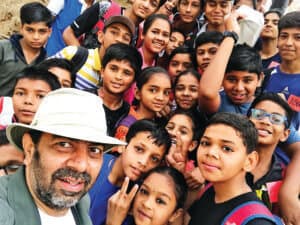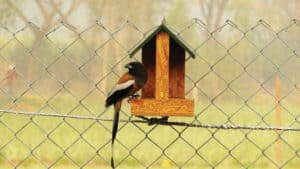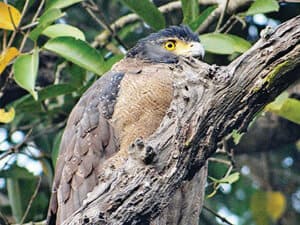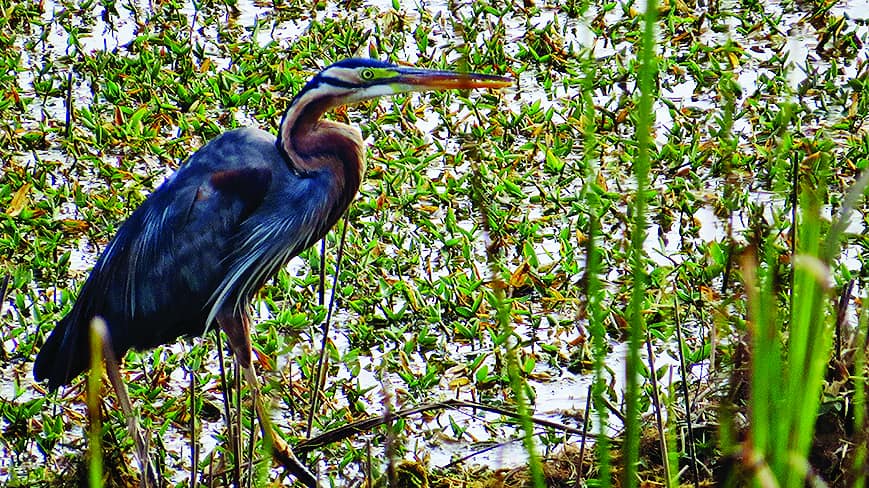Delhi has a thriving community of bird-watchers who knows there’s a whole new world to be explored every morning. And they find the experience akin to nirvana
This may seem strange, but Delhi, despite uncontained pollution and population growth, still hosts a greater variety of birds than any single city of the world, with the notable exception of Nairobi. Watching birds in their natural habitat is a way to connect with nature and your own inner self. You don’t have to do it alone: Delhibird is a group of more than two lakh bird enthusiasts who go out every weekend, early in the morning, to spy on birds in and around Delhi.
There used to be a smaller group of birders in Delhi by the name ‘Delhi Bird Watchers Society’ in the 1950s led by an Englishman. Indira Gandhi was an active member. Then, for a couple of decades, there was a lean phase, till Bill Harvey, another Brit, popularised birding in the city some 25 years ago. Many of his proteges are now leaders of the strong birding community in Delhi.
Delhibird members hail from varied backgrounds but share a common passion. They could be policemen, politicians or school students. Out in the field they’re all equals. In fact, you are as good a birder as your last sighting. And birds don’t discriminate. It takes a while and some practice, before internalising birding as an experience. It is only then that one is rewarded by glimpses into their unique mannerisms and peculiarities, as if they are fellow humans.

Okhla barrage, Sultanpur, Sanjay Van, Delhi Ridge — these are some of the spots frequented by birders. They get out of their beds predawn, assemble at an appointed place, and drive together in batches to watch birds. Many of them are well equipped, carry state-of-the-art binoculars, high-end cameras with long protruding lenses, and even telescopes that make birds perched on top of a barren tree some 200 meters away seem to be sitting on the tip of your nose. They love to list their sightings, do tripreports, which are shared on social networking sites.
Trudging through muddy fields, or by a lake or a river, constantly on the lookout, birders over years develop certain insights that are intuitive. The birds announce their presence to them as they scan the dense foliage, even though the bird in question, as small as a Minivet, might be sitting behind a thick leaf, on the top branch of a tall tree, nearly undetectable by the naked eye. These excursions are followed by a sumptuous community breakfast under a tree, or roadside, or in a dhaba, where birders share their experiences over coffee.
Every winter, Delhibird carries out a bird count, or census, where many groups of birders go to various designated spots, led by an experienced campaigner, and list their sighting over a day. Their findings are collected, complied and compared on a sunny afternoon over wine and lunch.
A hobby over the years has become a serious affair for Sanjay Tiwari, founder and CEO of Wellness QED. He along with Nikhil Devasar, last year converted Delhibird into ‘Delhibird Foundation’ with the objective to channelise this passion towards greater good, like environmental conservation, creating awareness, protection of wetlands and other bird habitat, help inculcate birding etiquette amongst the existing lot, encourage school children and — last but not least — partner in conservation efforts with industry and government.

Tiwari’s love for birds started some 20 years ago, when he went with his family to Bharatpur and hired a rickshaw — who turned out to be an excellent guide — to go around the bird sanctuary. He was amazed by the sheer variety of birds. After he returned to Delhi, he could appreciate the city’s avian population even more. “New horizons opened up for me,” he says. Soon, he found many like him who share a similar passion — watching birds as a window to nature.
Around the same time, some 20 years ago, Sunita Chaudhry was visiting her famous sister, Kalpana Chawla — the first Indian woman in space. It was Kalpana who introduced her to birding in the US and advised her to pursue it back in Delhi. Sunita told Kalpana with a straight face, “In Delhi there are no birds and birders.” Kalpana laughed at her response.
However, when Sunita came back to Delhi, she found a partner much younger than her, and the birding world spread open before her like the wings of a flying albatross. Sighting a bird is a spiritual experience for her; in those few moments, the world around her ceases to exist. “It’s akin to nirvana,” she says.
She never looked back after that. She became the integral part of the Delhibird community. “I’m an introvert person. Now I travel with my birder friends. I want to see abundance of birds not any particular bird. Birding opened a whole new world of birds and people, some of them conservationist. I made some lifelong friends,” she explains her tryst with birds.

Birding brings Sunita joy but it also makes her “suffer”. This love for birds leads her to deep reflection. Birders swarm a bird habitat in large numbers like honey bees. Plastic bags and pollution agonise her. Drink, food, urban milieus all contribute to degradation of the environment. “Sometimes I think, I shouldn’t have known so much,” she says, dejected.
Agrees Tiwari, “Birding is becoming a sport. They compete: Who has seen the maximum number of birds?” Tiwari adds, “The observers become intruders.” People who are concerned with sighting the most birds are called ‘twichers’. Overzealous photographers go to any extreme, even cause irreparable damage to the habitat, to sight a particular bird. For example, just to make sure they have a sighting, or are able to click a picture, these unscrupulous birders play on their mobiles recorded mating whistles of birds or calls of a predator. Birds get startled: In anxious excitement, they fly out of their hideouts to give these them an opportunity to click a picture to be later flaunted on a social networking site.
To curb this tendency, and to inculcate birding etiquette, Tiwari is introducing for the first time in India, the ‘Bird Hide Project’. Bird Hide is an enclosed cabin on an elevated platform, like a machan, specially designed for birders, to hide them while they witness birds in their full glory.
As someone famously said, “There are approximately 10,000 species of birds on the planet and no single individual has seen them all.” But it’s also true that there’s no single individual who hasn’t seen at least one of these 10,000 species.





